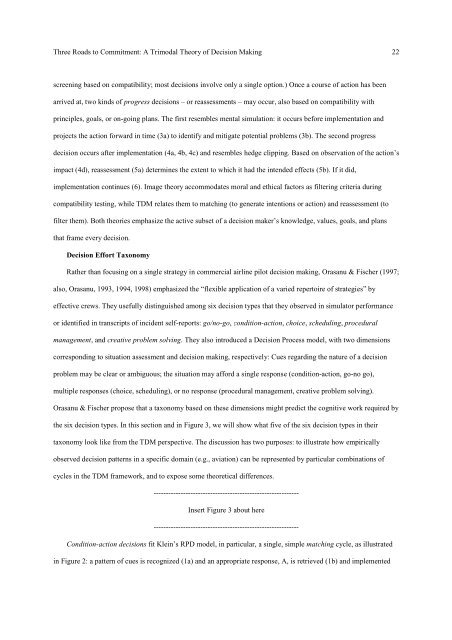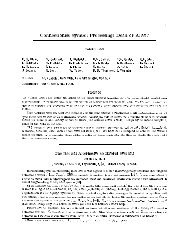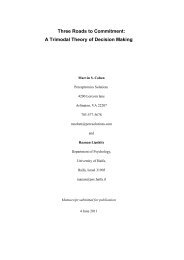Three Roads to Commitment: A Trimodal Theory of Decision Making
Three Roads to Commitment: A Trimodal Theory of Decision Making
Three Roads to Commitment: A Trimodal Theory of Decision Making
Create successful ePaper yourself
Turn your PDF publications into a flip-book with our unique Google optimized e-Paper software.
<strong>Three</strong> <strong>Roads</strong> <strong>to</strong> <strong>Commitment</strong>: A <strong>Trimodal</strong> <strong>Theory</strong> <strong>of</strong> <strong>Decision</strong> <strong>Making</strong> 22<br />
screening based on compatibility; most decisions involve only a single option.) Once a course <strong>of</strong> action has been<br />
arrived at, two kinds <strong>of</strong> progress decisions – or reassessments – may occur, also based on compatibility with<br />
principles, goals, or on-going plans. The first resembles mental simulation: it occurs before implementation and<br />
projects the action forward in time (3a) <strong>to</strong> identify and mitigate potential problems (3b). The second progress<br />
decision occurs after implementation (4a, 4b, 4c) and resembles hedge clipping. Based on observation <strong>of</strong> the action’s<br />
impact (4d), reassessment (5a) determines the extent <strong>to</strong> which it had the intended effects (5b). If it did,<br />
implementation continues (6). Image theory accommodates moral and ethical fac<strong>to</strong>rs as filtering criteria during<br />
compatibility testing, while TDM relates them <strong>to</strong> matching (<strong>to</strong> generate intentions or action) and reassessment (<strong>to</strong><br />
filter them). Both theories emphasize the active subset <strong>of</strong> a decision maker’s knowledge, values, goals, and plans<br />
that frame every decision.<br />
<strong>Decision</strong> Effort Taxonomy<br />
Rather than focusing on a single strategy in commercial airline pilot decision making, Orasanu & Fischer (1997;<br />
also, Orasanu, 1993, 1994, 1998) emphasized the “flexible application <strong>of</strong> a varied reper<strong>to</strong>ire <strong>of</strong> strategies” by<br />
effective crews. They usefully distinguished among six decision types that they observed in simula<strong>to</strong>r performance<br />
or identified in transcripts <strong>of</strong> incident self-reports: go/no-go, condition-action, choice, scheduling, procedural<br />
management, and creative problem solving. They also introduced a <strong>Decision</strong> Process model, with two dimensions<br />
corresponding <strong>to</strong> situation assessment and decision making, respectively: Cues regarding the nature <strong>of</strong> a decision<br />
problem may be clear or ambiguous; the situation may afford a single response (condition-action, go-no go),<br />
multiple responses (choice, scheduling), or no response (procedural management, creative problem solving).<br />
Orasanu & Fischer propose that a taxonomy based on these dimensions might predict the cognitive work required by<br />
the six decision types. In this section and in Figure 3, we will show what five <strong>of</strong> the six decision types in their<br />
taxonomy look like from the TDM perspective. The discussion has two purposes: <strong>to</strong> illustrate how empirically<br />
observed decision patterns in a specific domain (e.g., aviation) can be represented by particular combinations <strong>of</strong><br />
cycles in the TDM framework, and <strong>to</strong> expose some theoretical differences.<br />
-----------------------------------------------------------<br />
Insert Figure 3 about here<br />
-----------------------------------------------------------<br />
Condition-action decisions fit Klein’s RPD model, in particular, a single, simple matching cycle, as illustrated<br />
in Figure 2: a pattern <strong>of</strong> cues is recognized (1a) and an appropriate response, A, is retrieved (1b) and implemented




